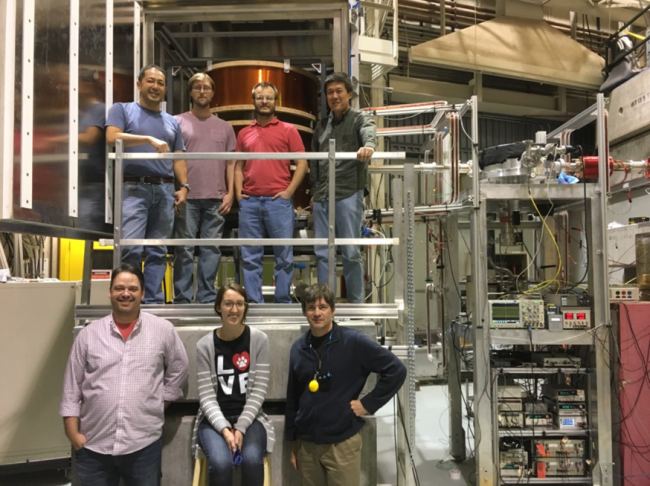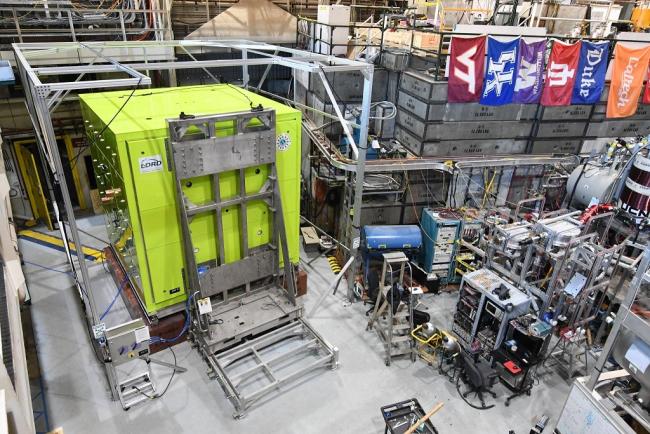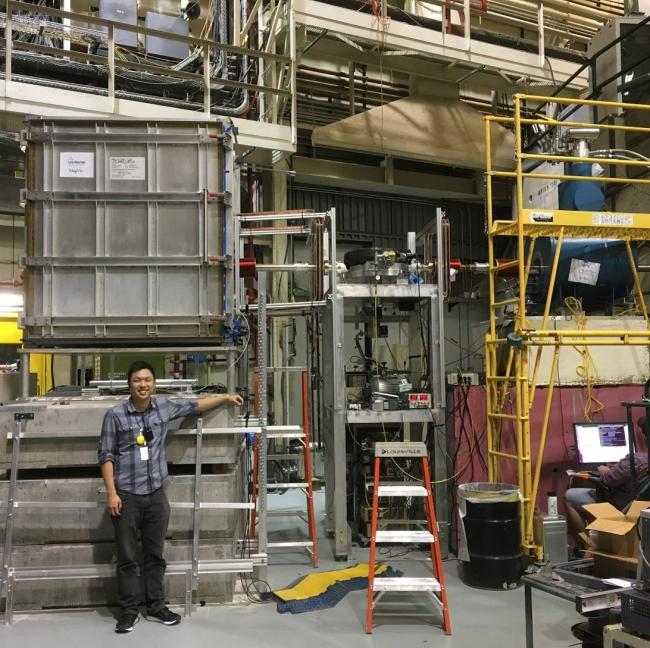nEDM@LANL
At LANSCE, the newly-completed upgrade of the UCN facility [Ito2018] provides the necessary UCN density to meet the demand of an nEDM experiment with tenfold sensitivity improvement. A factor of 5--6 increase in the UCN output has already been achieved (as measured both in the UCNτ experiment [Gonzalez2021] and in an nEDM test apparatus [Ito2018]). The LANL nEDM experiment takes the same Ramsey approach by using a room-temperature apparatus coupled to the newly-upgraded, solid deuterium-based UCN source. The apparatus operates in a vacuum and uses Ramsey's method of separated oscillatory fields, which is a mature technology developed in prior nEDM experiments [Pendlebury2000, Baker2006]. The low-risk technology together with the high-yield UCN source at LANL opens up a timely opportunity to substantially increase the nEDM sensitivity before the nEDM@SNS experiment becomes fully operational.
We carried out preliminary measurements in 2018 using a prototype apparatus. Below is the photograph of a few collaborators posing in front of the test apparatus.

Over the past few years, we have prepared a dedicated area in area B experimental Hall and commissioned a large magnetically shielded room (MSR), which will provide a quiet environment to measure the neutron spin precession with reduced impact from external fields. The neutron beam lines, that direct UCN from the source to the precession chambers housed inside the MSR, are being constructed and testedd.

Ramsey's Method of Separated Oscillatory Fields:
We manipulate the neutron spins using an oscillating field applied at the direction perpendicular to the static B field. Below is how the spin vector evolves with time after a pi pulse, i.e., the oscillating field (of the resonant frequency with constant amplitude) turns on for just long enough to rotate the spin vector by 180 degrees:
In Ramsey's separated oscillatory field method, this pi pulse is split into two pi/2 pulses, which are separated by a long time. In the beginning, the spin of the neutron points up (along + z direction). After the first pi/2 pulse, the neutron spin vector is rotated by 90 degrees and is now freely processing under the influence of the static B and E fields. After a while, the second pi/2 pulse turns on. If the frequency of the oscillating field matches the Larmor precession frequency, then the spin of the neutron rotates by another 90 degrees, causing the spin of the neutron to point downwards (along -z direction).
With this knowledge, we can make a Ramsey's interferogram. In order to visualize the fringes, one needs to repeat this spin rotation many times, each time changing the frequency of the oscillating fields slightly. The following video shows the evolution of the spin-up neutron under three different oscillating fields: one below the resonance, one on the resonance, and the last one above the resonant frequency:
These nice simulations and animation of the neutron spin gymnastics were made by Doug Wong, a graduate student working on the experiment for his dissertation research. Below is a photo of Doug standing in front of the nEDM test apparatus.

The responsibilities of our group include:
- Neutron spin analysis using simultaneous spin analyzers.
- Comagnetometer implementation using laser-polarized Hg atoms.
- Degaussing of the magnetically shielded room.
- Gradient field generation and control.
- Slow control and data acquisition.
- Spin transport and Monte-Carlo simulations
Research Opportunities:
The construction of the nEDM apparatus has been funded jointly by the MRI program at NSF and by the LDRD program at LANL. At this point, we are looking for one postdoc, two graduate students, and several undergraduate research assistants to join this effort. If you are interested, please contact us.
People currently on this effort:
- Chen-Yu Liu (PI)
- Jennie Chen (postdoc)
- Austin Reid (postdoc)
- Douglas Wong (graduate student)
- Maria Dawid (graduate student)
- Joshua Burdine (incoming graduate student)
- Alicen Houf (undergraduate research assistant)
- Gregory Gills (undergraduate research assistant)
